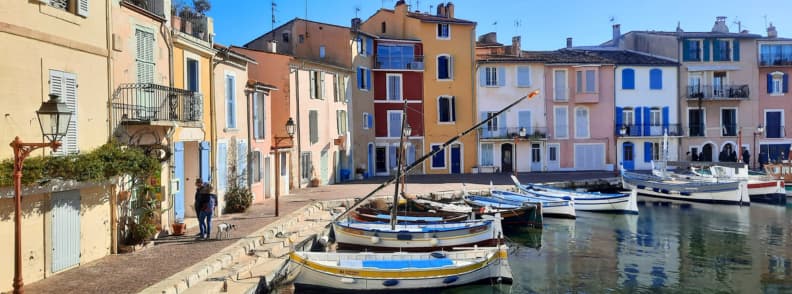Planning a visit to Étang de Berre in France? This Étang de Berre travel guide is your trustworthy start. I wrote it to help you visit Étang de Berre with confidence, find the best Étang de Berre things to do, and understand Étang de Berre tourism without the guesswork.
I first came here in February on a weekend camper trip after Les Baux de Provence. We parked by the lake at Saint-Chamas late in the day and watched the sunset turn the sky red. The next morning was calm and silent except for two storks. My first impression was simple. Tranquil. Reflective. Untouched by mass tourism.
The Travel Bunny’s Étang de Berre travel guide focuses on what matters. Clear directions, real parking tips, and honest timing. I will tell you which towns work as a base. I will show you where people swim, and when to avoid the water. I will point to verified sources for bathing water quality and seasonal rules. No hype. Only what I saw and what you need.
Think of the lagoon as a calm alternative to the French Riviera and the Camargue. You can get canals in Martigues, Roman history in Saint-Chamas, and nature that still feels close.
Étang de Berre Travel Guide
If you want reliable logistics and a straight answer on safety, you are in the right place. Let’s start with an overview, then move into routes, beaches, and practical tips that save you time.
Disclosure: Some of the links below are affiliate links. This means that at no extra cost to you, The Travel Bunny will earn a small commission if you click through and make a purchase. Thank you!
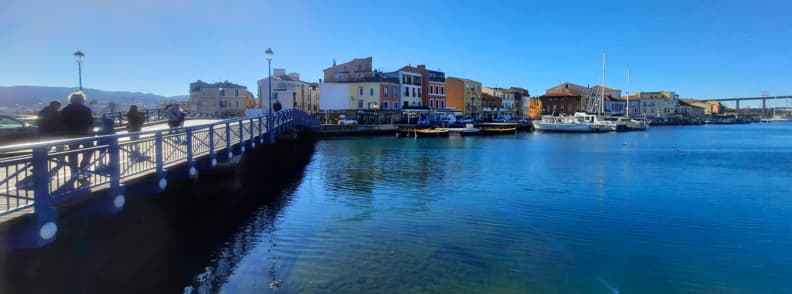
Why Visit The Étang De Berre Region
Étang de Berre is one of those Provence hidden gems that few travelers take the time to explore. It’s the second-largest saltwater lagoon in Europe, stretching across 155 square kilometers of still, shifting light. Framed by Martigues, Saint-Chamas, Istres, and Berre-l’Étang, it sits quietly between Marseille and Aix, a landscape where the rhythm of the water sets the pace of the day.
This lagoon is both wild and lived-in, where industry meets nature, and a long environmental recovery has started to show. The cleanup that began decades ago is working. Fish have returned, water clarity improves each season, and the beaches reopen for swimming each summer.
If you’re searching for South of France escapes that feel authentic, Étang de Berre belongs on your list. It combines the brightness of the southern France lakes with the quiet of inland Provence. The atmosphere feels familiar to anyone who loves the Camargue, yet it’s closer to Marseille and far easier to reach on a weekend trip.
For travelers who love photography, Étang de Berre nature delivers endless frames. The lagoon’s changing colors move from silver at sunrise to deep blue at dusk. Étang de Berre viewpoints from Cornillon-Confoux or the Aqueduct de l’Horloge in Saint-Chamas give wide, open perspectives of water and sky. In winter, the calm surface becomes a mirror, a gift for Étang de Berre photography and reflection shots that rival any coastal sunset.
Now let’s speak about Étang de Berre eco-tourism. The small villages around the lagoon rely on local products, quiet walking trails, and low-impact water sports instead of large resorts. You can camp, hike, or park your van by the lake without disturbing the rhythm of the place.
When we visited in February with the camper, it was silent. Parking was easy, and the air smelled of salt and pine. The lagoon reflected a pale sky. It felt almost private, perfect for travelers who like solitude and clear views. For photographers, slow travelers, or anyone seeking an off-season retreat, this part of Provence is a haven of pure calm.
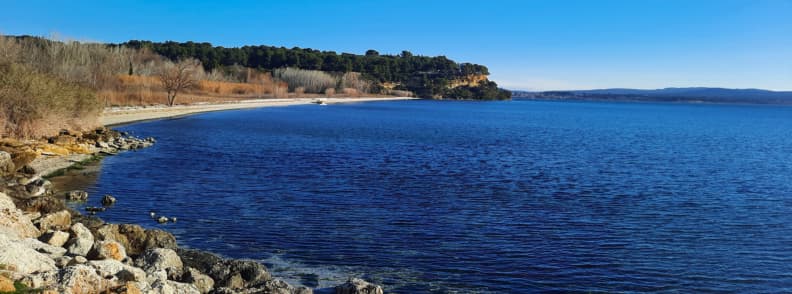
Water-Quality Facts & Swimming Safety
The first question most people ask before planning a swim here is simple: is Étang de Berre polluted? The short answer is no, not anymore. The long one is worth reading, especially if you care about choosing clean, certified Étang de Berre beaches.
This lagoon was once one of France’s most industrialized waterways, but a long cleanup effort has changed that story. Since 2013, local authorities have worked to restore the water’s balance, and today, several beaches meet strict EU bathing standards.
You can verify the water quality Étang de Berre beaches directly on the official government site. It lists all monitored bathing zones, updated daily during the summer season. This transparency builds confidence, something travelers rarely find for lesser-known lagoons in France.
Here’s what the data says. The Ferrières Beach in Martigues and Les Cabassons Beach consistently score Excellent for cleanliness. They are the safest swimming safe spots Étang de Berre, for families and anyone who prefers calm, shallow water. Romaniquette Beach in Istres is also a popular choice but sometimes rated Good or Sufficient, depending on rainfall and seasonal testing. The smart move is to check real-time quality before you go.
If you follow the swimming rules Étang de Berre France, you’ll notice they’re clear: swim only in marked and monitored zones, respect seasonal lifeguard schedules, and avoid untested industrial edges near Fos-sur-Mer. These rules protect both the water and the swimmers who enjoy it.
I visited in February. It was too cold for Étang de Berre swimming, but the water looked glassy and clean, reflecting the sky like a mirror. It felt reassuring to see how clear it had become. Next time, I’d return in late spring, the season when the beaches reopen, the locals set up umbrellas, and life returns to the shore.
The Travel Bunny’s Insight: The best beaches Étang de Berre region are scenic and scientifically verified. That’s rare for such a quiet corner of Provence. If you value peace, proximity, and safe swimming in natural surroundings, this lagoon deserves your trust.
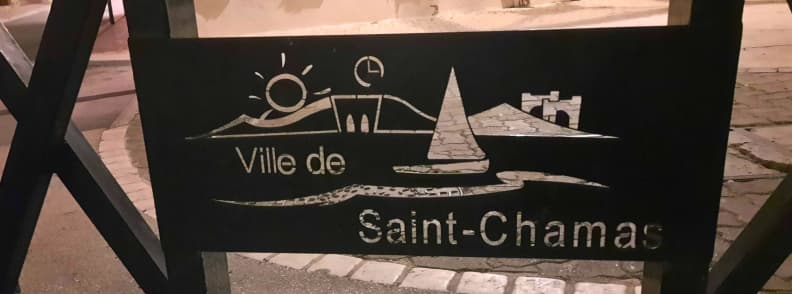
Saint-Chamas With Roman History & Troglodyte Caves
If you want to visit Saint-Chamas for a day, come with two ideas in mind: history carved in stone and a slice of small-town Provence that changes with the light. For those planning Saint-Chamas travel, this is one of the oldest settlements around the lagoon, perched above the north shore of the Étang de Berre.
This small town blends Roman engineering, cliff-side dwellings, and a quiet local life that still runs on market hours. The highlight of Saint-Chamas is the Pont Flavien, a perfectly preserved Roman bridge that still dominates the Touloubre valley more than two thousand years after it was built. Dating to around 10 BC, this 22-metre-long and 6-metre-wide Saint-Chamas bridge once carried the main Roman road linking Marseille to Arles, making it one of the most remarkable ancient structures in Provence.
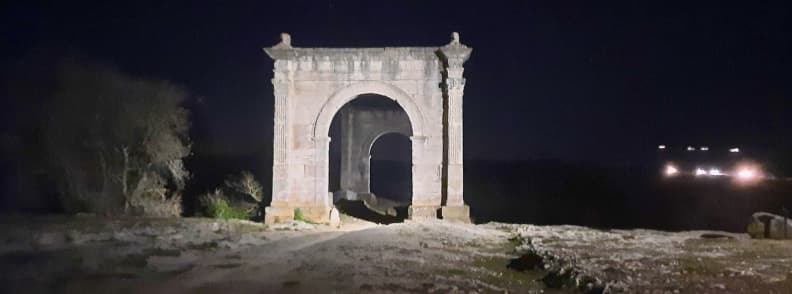
The Pont Flavien is a living monument, still standing on its original limestone vault after centuries of use. According to the Latin inscription carved into its twin triumphal arches, the bridge was commissioned by Lucius Donnius Flavius, a wealthy local notable and priest (flamine) of Rome and Augustus, who ordered it built in his will under the direction of Caius Donnius Vena and Caius Atticus Rufus. For nearly twenty centuries, it remained the only crossing point over the Touloubre, used constantly but rarely maintained. When the ancient paving wore away, carts began to roll directly on the stone vault, leaving deep ruts that are still visible today.
By the 17th century, the bridge was close to collapse. It was restored thanks to the efforts of a city councilman named Surian, and for generations locals called it the Pont Surian. During World War II, the northern arch was damaged by an American truck. Engineers dismantled it, built a temporary Pont Américain beside it, and left it in service until 1955, when a new road bridge finally replaced the old Roman crossing. After almost 2,000 years of service, the Pont Flavien earned its retirement, and in 1840, it became one of France’s earliest Monuments Historiques.
Today, the limestone glows honey-gold in the evening light, the carved arches framing the river like an ancient gateway. Photographers love the scene. Bring a tripod for a clean shot between cars, or come early morning when the mist still hangs above the water.
The Saint-Chamas Roman bridge also marks a stage on the Sentier du Patrimoine de Saint-Charles, an 11 km heritage walk (180 m elevation gain, around three hours) that connects the Pont Flavien with Roman remains, aqueducts, and panoramic views of the Étang de Berre. It’s the perfect short hike for history lovers and curious travelers.
Above the old quarter, the maisons troglodytes Saint-Chamas show how families once lived directly inside the rock. They’re easy to reach on foot from the center, a short walk through narrow streets lined with pastel houses and shuttered workshops. Continue upward to the aqueduct Horloge Saint-Chamas (also called the Plan de l’Horloge viewpoint) for a broad panorama over the Étang de Berre. It’s one of the most rewarding angles for anyone serious about local photography.
Etang de Berre Travel Tip: Use the town hall’s Saint-Chamas Map to explore the town.
Daytime is when the village feels most alive. The weekly Provencal market fills the main square with produce and soap stalls, and a few artisan shops in Saint-Chamas sell ceramics and olive oil. You can pick up food for a picnic or browse the local markets Étang de Berre area before heading toward Parc de la Poudrerie, the nearby nature reserve shared with Miramas.
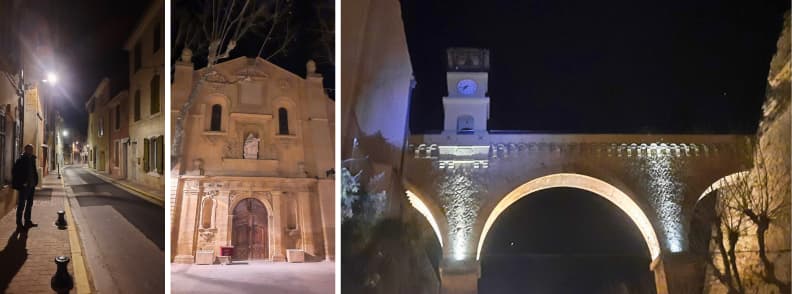
After dark, Saint-Chamas shifts. When we returned to town after sunset to look for dinner, the charm was gone. Streets were empty, a few bars stayed open, and the only open restaurant was upscale and deserted. We bought takeaway pizza from a small place with a good Google rating and ate in the camper by the lake instead.
Etang de Berre Travel Tip: In low season, Saint-Chamas changes after dark, so plan to eat early.
Despite the quiet evenings, this town remains one of the best Saint-Chamas attractions for travelers interested in Roman architecture and authentic Provençal rhythm. Explore during the day, photograph the Pont Flavien, climb to the aqueduct, and move on before the shops close. The next morning, we did exactly that, pulling away toward Martigues as the first sunlight hit the arches, leaving Saint-Chamas calm and still behind us.
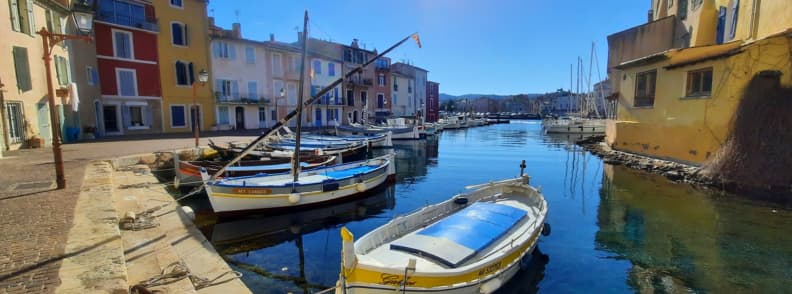
Martigues, The Venice of Provence
When you visit Martigues, you understand why locals call it the Venise Provençale. The town is built on three islands linked by low bridges and canals that connect the Mediterranean to the Étang de Berre. The reflections of pastel façades on calm water make it one of the most photogenic spots in Provence. For anyone planning Martigues tourism, this is a place that feels both seaside and inland, both lively and laid-back.
If you wonder why is Martigues called the Venice of Provence?, the answer is simple. It’s built on water. Every street leads to a canal, every bridge frames another reflection. It’s a smaller, quieter version of Venice, filled with Provençal color instead of marble.
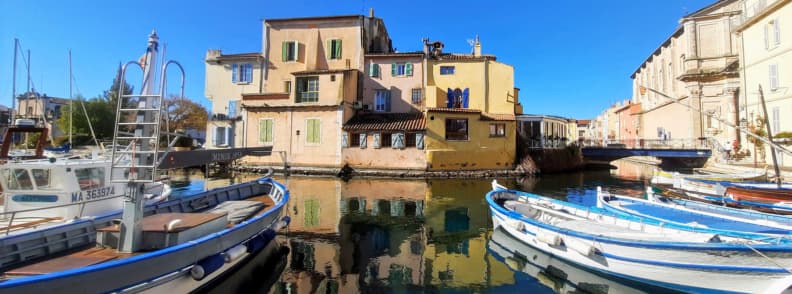
Martigues is the colorful, cultural heart of the lagoon and the best base for exploring the area without crowds. The Martigues old town unfolds around the Miroir aux Oiseaux, a small harbor on Quai Brescon once lined with fishermen’s houses and wooden boats. In the early morning, the canal lies still enough to reflect every mast and every color, becoming a perfect mirror. This spot captures Martigues’ soul, where history, art, and daily life meet.
As writer Alexandre Dumas once said, Martigues is to Venice what a charming peasant girl is to a great lady; it would have taken only a king’s whim to make the villager a queen. That contrast still defines this place. Once, the old fishing quarter stretched toward the Étang de Berre, all the way to the Pointe du Brescon. Early 20th-century works reshaped the canal, replacing the Pont du Roi with a drawbridge in 1929, then with today’s lifting bridge in 1962. The canal Saint-Sébastien, the Miroir aux Oiseaux, and the Quai Brescon form a protected historic site since 1942, preserving the charm that painters loved.
The old fishing boats (tartanes) have disappeared, and no nets dry on wooden frames anymore. The ground-floor workshops are now homes, but the scene remains the same: colorful façades, irregular roofs, and reflections rippling beneath the Saint-Sébastien bridge. The composition feels timeless, the same view that artists once painted and locals still call la petite Venise.
Martigues Photo Tip: At sunrise, standing here feels like stepping inside a living painting. It’s one of the most authentic photo spots in Martigues and the heart of Martigues tourism today.
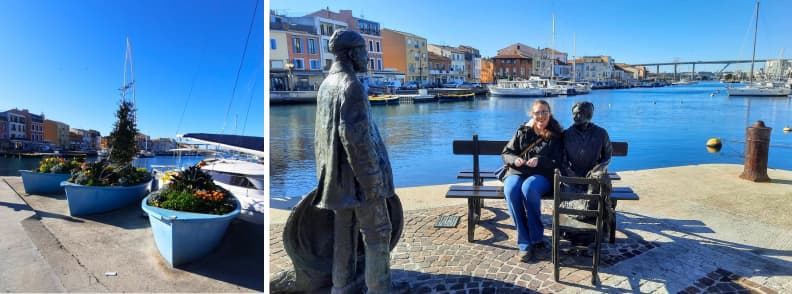
On your way to the Miroir aux Oiseaux, stop to notice the statue Le Pêcheur et la Ramendeuse, a bronze tribute to the fishermen and net-menders who once defined local life. It sits beside a small bridge that perfectly frames the harbor, a quiet spot for photos and one of the best vantage points at sunset.
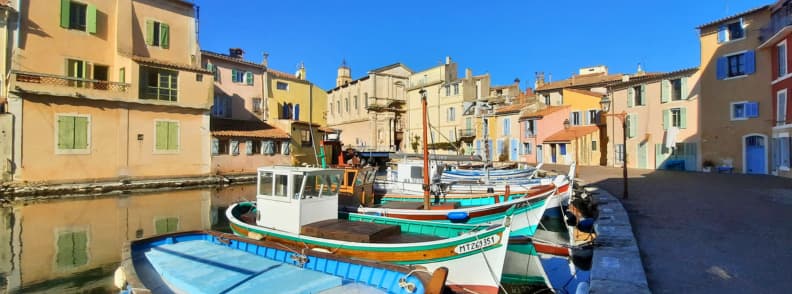
A few steps away from the Miroir aux Oiseaux stands the Église Sainte-Marie-Madeleine, an elegant 17th-century church, recognizable by its pale stone façade and bell tower. Inside, you’ll find marble altars and baroque details that reflect Martigues’ prosperous maritime past.
After visiting the Miroir aux Oiseaux, you will notice the Église Saint-Genest, one of the oldest churches in town, standing on the Jonquières side. Its foundations date back to the 12th century, and its simplicity contrasts beautifully with the ornate Madeleine church. Together, they anchor the town’s skyline, one by the canal, one above it.
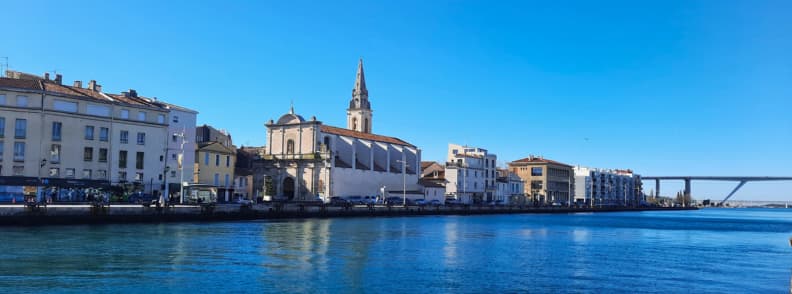
You can walk from here through narrow lanes to Musée Ziem. Works by many of the artists who painted in Martigues, including Ziem himself, fill its walls. Ziem’s Vieux Port de Marseille hangs beside paintings by André Derain, Raoul Dufy, and Paul Signac, while François Picabia’s 1905 “Étang de Berre” captures the lagoon’s restless movement. The upper floor adds a local dimension with archaeological and ethnological exhibits that trace how life evolved around the water.
Continue uphill to the Chapelle de l’Annonciade, whose terrace opens over rooftops and the sea light. Across the bay, the Fort de Bouc guards the channel to the Mediterranean and can be visited on guided boat tours in summer.
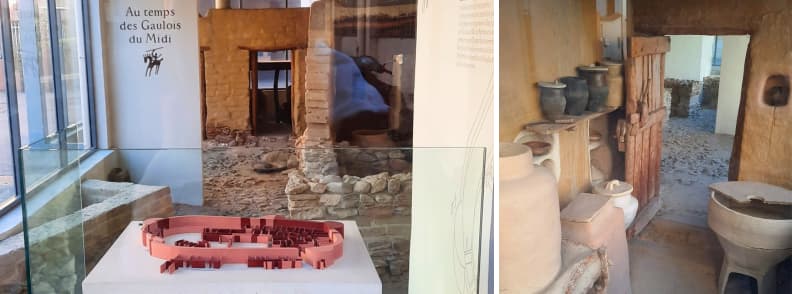
Le Village Gaulois du Midi. Tracing Martigues’ Ancient Origins
Few visitors know that Martigues was first a Gaulish island settlement, founded over 2,500 years ago at the crossroads of land routes between Arles and Marseille and the maritime channel linking the Étang de Berre to the sea. Excavations between 1978 and 2001 uncovered one of the most evocative Iron Age sites in Mediterranean France, known today as the Village Gaulois du Midi.
This archaeological site reveals how early Celtic settlers shaped Martigues long before the Romans. Built around the 5th century BC, the village consisted of narrow alleys and small single-room clay houses with earthen walls and reed roofs. Its inhabitants farmed, fished, raised animals, and traded with the Greeks of Marseille, adopting viticulture, olive cultivation, and early writing by the 3rd century BC. The site saw several waves of destruction (by Greek and later Roman forces) and was rebuilt each time, growing more complex with every phase.
Today, an 80 m² section of this ancient habitat has been faithfully reconstructed at Place Maritima, right in Martigues’ old quarter. The exhibit brings to life the daily gestures of the Gaulois du Midi, from pottery and weaving to bread-making and grain storage, all within the intimate scale of homes that once defined this island community. Visiting the Village Gaulois du Midi offers a rare chance to step back into the origins of Provence and see the roots of Martigues’ long bond with the water, trade, and light that still shape it today.
Things To Do In Martigues
For travelers looking for things to do in Martigues, start with a slow walk along Quai Brescon and Quai des Pêcheurs. Stop for coffee where fishermen unload their catch. Visit the small Sunday market for local olive oil, bread, and the famous Martigues bottarga (poutargue), a cured mullet roe used in Mediterranean cuisine. In the afternoon, cross to Ferrières Beach for a swim or sunbreak. It’s one of the best Martigues beaches for its calm, lagoon-facing location. If you prefer sea waves, the beaches of Carro and Sainte-Croix on the Côte Bleue are only a short drive away.
I loved Martigues from the moment we arrived. Even in winter, when many coastal towns shut down, cafés here stayed open, and the canals still buzzed with daily life. It felt a bit like the Camargue, just closer to home. The winter light made the water silver-blue, perfect for photography. For anyone interested in Martigues tourism or off-season travel, bring your camera and patience because the reflections at dusk are unforgettable.
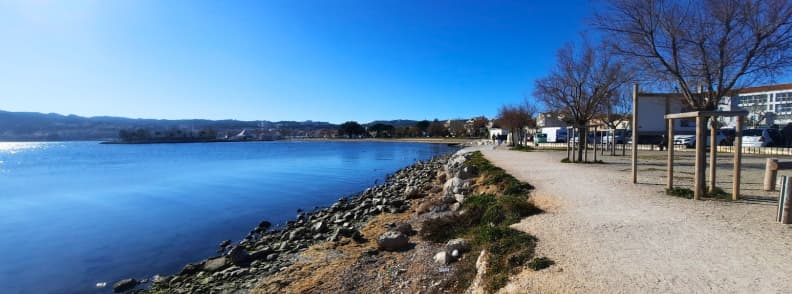
Most visitors overlook practical details, but here’s what helps. Free parking is available near the port in the low season, and the walk from there to the old town takes less than ten minutes. The best cafés and Martigues restaurants line Quai Brescon and the old harbor. In summer, they fill fast at lunchtime, but in February, we found open tables and quiet service.
If you want a genuine Venice of Provence experience, skip the postcards and walk early or late in the day. You’ll have the canals almost to yourself, the light will be soft, and the reflections will look like paintings.
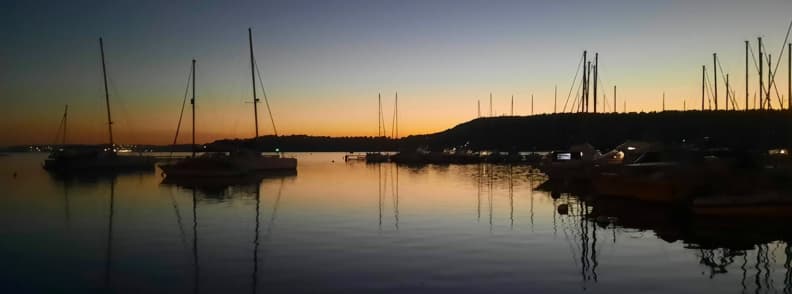
Active Étang de Berre. Water Sports & Nature
If you come in summer, Étang de Berre kayaking and Étang de Berre sailing are two of the best ways to experience the lagoon up close. The calm, wide surface makes it perfect for beginners, families, and anyone who prefers quiet water over strong sea currents.
Beyond the scenery, Étang de Berre is a playground for gentle outdoor adventure and easy eco-friendly fun. The main hub for nautical activities is the Cercle de Voile de Martigues (CVM), one of the oldest sailing clubs in the region. They run classes, equipment rentals, and fun options like towed-buoy rides for about €19 per person. It’s also a good base for sailing small catamarans and paddleboarding. For independent travelers, Étang de Berre boat tours leave from Martigues and Istres in summer, offering short sightseeing circuits across the lagoon.
Prices are straightforward, and you can compare water sports Étang de Berre price listings directly on the CVM or Martigues Tourism websites before you go. Small-boat and paddle rentals are also available in Istres and Saint-Miter-les-Remparts, both close enough for day use. Many local shops post Étang de Berre boat rental prices outside, so look for daily rates around €15-25 for kayaks and €50-100 for small motorboats, depending on season and gear.
Beyond the water, the area rewards slow travelers who like to move under their own power. Étang de Berre cycling paths circle long stretches of flat shoreline, with views that open over salt meadows and fishing huts. There are short, scenic loops near Martigues and longer routes connecting Saint-Chamas and Miramas. If you prefer walking, Étang de Berre hiking trails link to the GR2013, passing olive groves and low cliffs above the lagoon.
Wildlife lovers should not skip Étang de Berre birdwatching. Around Parc de la Poudrerie, between Saint-Chamas and Miramas, you can see flamingos, herons, egrets, and ospreys feeding in shallow water. Bring binoculars and go early. The first light over the reeds is the best time to spot them.
When we visited in February, the air was too cold for water sports, and most clubs were still closed for the season. But the lagoon was glassy and still, ideal for watching birds glide across the surface. I made a note to return in summer, when the same water that looked frozen under winter light turns into a busy scene of sails, paddles, and laughter.
Visit Étang de Berre Tip: Book activities a few days ahead in high season, especially weekends. Many clubs close for lunch or require reservations for tours. Check the CVM and Martigues Tourism websites for current rates and opening hours.
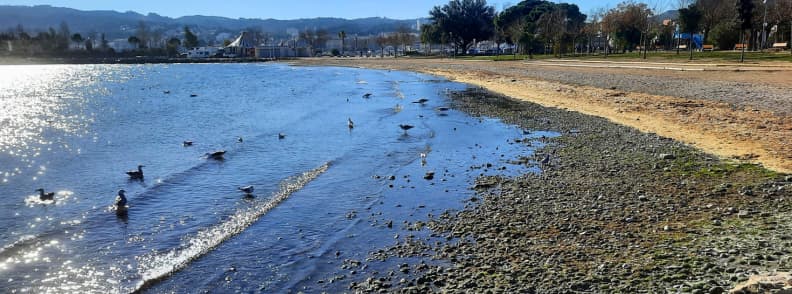
Best Beaches & Where You Can Swim At Étang de Berre
Most travelers don’t expect to find real Étang de Berre beaches, but they exist, all quiet, shallow, and surprisingly scenic. The lagoon may not have the turquoise flash of the French Riviera, yet it offers calm, family-friendly stretches of sand where you can swim safely and enjoy a slower rhythm.
The best beaches in the Étang de Berre region are local spots used by residents, not resort crowds, and they come with clear safety data you can check before you swim. Here’s a practical overview of the main Martigues beaches and nearby options:
| Beach | Town | Facilities | Lifeguard (Summer) | 2024 Water Rating |
| Ferrières Beach | Martigues | Showers, snack bar, parking | Yes | Excellent |
| Romaniquette Beach | Istres | Playground, cafés, shaded areas | Yes | Sufficient (variable) |
| Ranquet Beach | Istres | Picnic tables, small car park | No | Good |
| Plage du Jaï | Marignane | Long sand strip, surf zone | Partial | Good |
| Les Cabassons | Martigues | Quiet cove, basic facilities | No | Excellent |
These are the best beaches Étang de Berre region according to official monitoring. Ferrières Beach in Martigues is the easiest to reach and best equipped. It’s lifeguarded, central, and close to cafés. In summer, families gather here with coolers and paddleboards. In winter, I saw it empty and pale under the sun, full of seagulls getting warm. It looked peaceful but not inviting for a swim.
Romaniquette Beach and Ranquet Beach, in Istres, are the most kid-friendly beaches Martigues visitors can reach quickly by car. The water is shallow, and the playground by Romaniquette makes it easy for parents. The beach sometimes scores Sufficient in water tests after heavy rain, so always check the live results before swimming.
For those who prefer wind and space, Plage du Jaï between Marignane and Châteauneuf-les-Martigues is a narrow, endless line of sand, perfect for kitesurfers and long walks. It’s one of the few places where you can see both the lagoon and the airport runways across the water.
If you’re chasing Étang de Berre hidden beaches, drive toward Les Cabassons, a lesser-known cove near Martigues. It’s quieter, rarely crowded even in July, and rated Excellent for water quality.
Parking is usually simple outside July and August. The easiest parking tips Martigues: use the Ferrières Beach lot or park near the port, then walk ten minutes along the promenade to get to town, like we did. At Romaniquette Beach, arrive early on weekends; space fills by mid-morning.
I only saw a few of the beaches on my February trip, but that view stayed with me, with untouched sand and glassy water. In winter, the beaches are empty, peaceful, and photogenic. In summer, they shift into local social spots full of families and picnic tables. The change of season defines the lagoon, and knowing where to swim safely makes it all the more enjoyable.

Where to Eat At Étang de Berre. Local Food & Lakeside Restaurants
Food around the lagoon is simple, salty, and shaped by the water. You’ll find small Étang de Berre restaurants serving grilled fish, local olives, and the region’s proudest specialty, bottarga, known here as poutargue. It’s made from cured grey-mullet roe, pressed and salted until firm, then sliced thin like sea-flavored gold.
Eating at Étang de Berre restaurants connects you to the lagoon’s rhythm. Meals are slower, flavors are cleaner, and restaurants depend on daily catches, not menus printed months ago.
In Martigues, the food scene is stronger than anywhere else around the water. The canals, the fishing boats, and the small terraces give you more choice and a livelier feel than neighboring towns. If you want to try the real boutargue Martigues, look for it at the local fish market or at Maison de la Poutargue, where you can also buy a slice to take home. You can order it as an appetizer, cut paper-thin over buttered toast with a glass of chilled white wine.
For a proper meal, L’Alchimiste in Berre-l’Étang is one of the best lakeside restaurants Étang de Berre for fine dining. The chef works with Provençal produce and seafood caught nearby, turning simple ingredients into something elegant without losing the soul of the place. In Martigues, Le Miroir, on Quai Brescon, pairs fresh fish and poutargue pasta with canal views. The light hits the tables in late afternoon, and it’s ideal for photos and a slow meal.
If you prefer something casual, there are good options too. Chez Francine serves unfussy Mediterranean dishes, all fresh, all local. And in low season, when most restaurants shut early, La Storia 2 in Saint Chamas does honest takeaway pizza that tastes far better than you’d expect from a late-night spot.
For coffee, stop by any of the best cafés Étang de Berre area around Martigues’ old port. Most stay open year-round, even when restaurants close midweek. Sit by the canal, watch the reflections, and listen to locals arguing about the weather. That’s the rhythm of everyday Provence.
Our own off-season dinner in Saint-Chamas was a reminder of how quiet the lagoon can get in winter. When we went to town after sunset, looking for food, we found Le Bistrot de Provence packed with loud regulars at the bar and upscale Le Rabelais, the only other restaurant still open, completely empty. Everything else was pizza or burgers, mostly take-away. In the end, we got pizza and a bottle of chilled rosé from La Storia and ate it in the camper by the lake. It was one of those practical travel choices you remember fondly, and it taught us two important things for our future camper trips: carry a wine stock and add a corkscrew to the inventory.
Étang de Berre Local Tip: In summer, book tables early and aim for weekday lunches when the quays are quieter. Off-season, always check opening hours before sunset. Dining late can turn into a scavenger hunt.
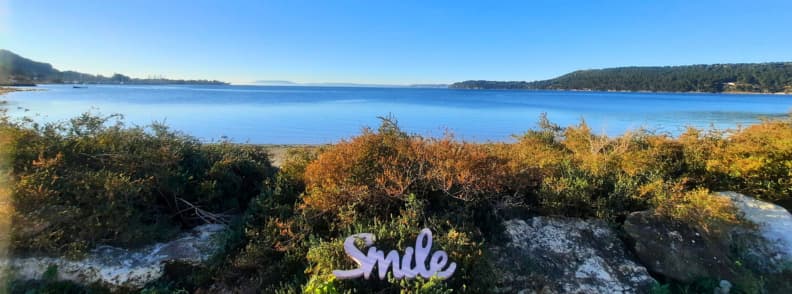
Where To Stay At Étang de Berre. Hotels, B&Bs & Campings
Finding where to stay at Étang de Berre depends on what kind of traveler you are. The lagoon stretches between Martigues, Istres, and Saint-Chamas, and each side offers a different rhythm. You can wake up to canal reflections, sleep beside the beach, or park your camper under pine trees with a sunrise view. There’s accommodation for every budget and style here, from waterfront comfort to quiet, low-impact camping.
If you prefer comfort, Étang de Berre hotels in Martigues are the best base. Small canal-view rooms around Quai Brescon and Ferrières give you the charm of the Venice of Provence with easy access to restaurants and beaches. Ibis Martigues Centre stays reliable and central, with free parking and walking distance to the old port.
For something more local, Le 5 Hôtel has bright rooms near Ferrières Beach and the canals, ideal if you want to wake up and step straight into the heart of town. Golden Tulip Martigues Provence adds rooftop views and a small pool, perfect for travelers who like style and convenience. These hotels work well for short visits or anyone doing slow-paced budget travel Étang de Berre with easy logistics.
If you travel light or prefer open air, Étang de Berre camping options stretch along the shoreline. The best option is Camping Félix de la Bastide in Saint-Mitré-les-Remparts, one of the most scenic camping locations Étang de Berre. It’s one of those rare eco-friendly stays Étang de Berre, right on the lagoon edge, shaded by pines, with pitches for tents, vans, and mobile homes. You fall asleep to frogs and wake up to calm water. You’ll have direct access to swimming areas, making it perfect for families. And the site runs on eco-responsible principles (solar water, selective recycling, and minimal concrete).
Kitesurfers tend to gather further east and closer to Marignane, at Camping Marina Plage. It gives them quick access to a windswept beach where sails dot the horizon at sunset. Both campsites stay well-rated and open through most of spring to autumn.
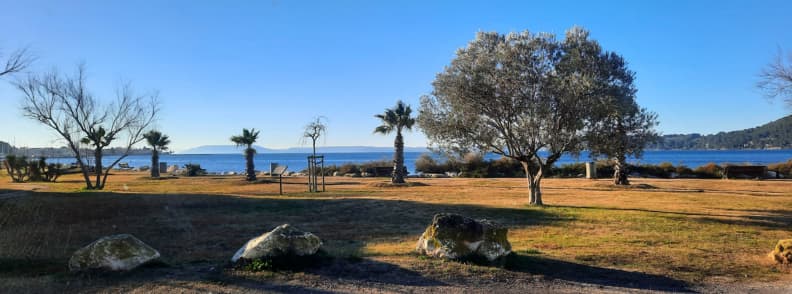
For camper travelers like us, there’s also a perfect free stop. We parked by the lake at Saint-Chamas, near the Parc Public. It’s flat, free, and safe. There’s a playground nearby and even a small outdoor workout area. In the morning, the water was silver and the air still. It was a scenic spot for breakfast with a view. Plan to arrive early in high season, because even in winter, it was pretty full.
If you’re on a budget travel Étang de Berre, this free overnight option is unbeatable, especially off-season when campgrounds close. It also gives a sense of local life. You wake up to joggers, storks, and soft morning light on the arches of the Pont Flavien in the distance.
Camper Travel Tip: Stock food and fuel before sunset in winter. After dark, most towns close early, and petrol stations can be far apart.
Wherever you stay (hotel, campsite, or lakeside aire), the common thread is stillness. You’re close to Marseille but far from its noise. The lagoon gives you space to breathe, a slower morning, and a real glimpse of an almost deserted everyday Provence without tourists.
Getting to Étang de Berre & Around (Road, Rail, Airport, Parking)
Étang de Berre is simple to reach but still feels hidden. Whether you drive, take the train, or plan day trips from Aix-en-Provence to Étang de Berre, the access is straightforward and flexible.
Getting from Marseille to Étang de Berre is easy. The lagoon sits only forty minutes away by car, along the A55 or A7 motorways. Once you pass the industrial edge of Fos-sur-Mer, the road opens to calm water and fishing towns. It’s close enough for a spontaneous day trip, but different enough to feel like you’ve escaped the city.
If you’re arriving by air, Marseille Provence Airport Marignane sits right on the lagoon’s eastern edge. You can literally see the water from the runway. Picking up a car there is the fastest option. Étang de Berre car rental counters operate directly in the terminal, and the drive to Martigues or Saint-Chamas takes less than thirty minutes.
Discover cheap car rental in Marseille from 10 euro, with free cancellation
If you prefer not to drive, trains and buses link the main towns easily enough. The TER line to Croix-Sainte station drops you near the center of Martigues. From there, local buses or short walks connect you to the canals, beaches, and cafés. Public schedules can be thin in the evening, so check times before returning to Marseille. Still, if you rely on public transport to Étang de Berre, this route is the simplest.
Find a train to Croix-Sante Station
For navigation, keep an updated Étang de Berre map on your phone. Many small roads loop around the lagoon, leading to viewpoints and fishing hamlets. Expect narrow bends near Saint-Chamas and Miramas, where the lake almost touches the cliffs.
Étang de Berre parking is rarely a problem outside high summer. In Martigues, the best spots are near Quai Brescon for canal access and the Ferrières Beach lot for swims or evening walks. In Saint-Chamas, the lakefront parking next to the public park is flat and quiet.
If you’re planning multiple stops, driving remains the best option. The lagoon is ringed by small French villages that connect by scenic roads, not highways. Having your own wheels gives you time to stop for photos, grab local bread in Miramas, or catch sunset in Martigues.
For a relaxed Provence itinerary, pair Étang de Berre with day trips from Aix-en-Provence to Étang de Berre or from Marseille. The distances are short, but the change of pace is real. One hour later, you’re trading city traffic for quiet shores and flamingos.
Bouches-du-Rhône Travel Tip: Avoid rush hours on the A7 near Marseille. Leave early morning or late afternoon for smooth driving and open views of the lagoon as you arrive.
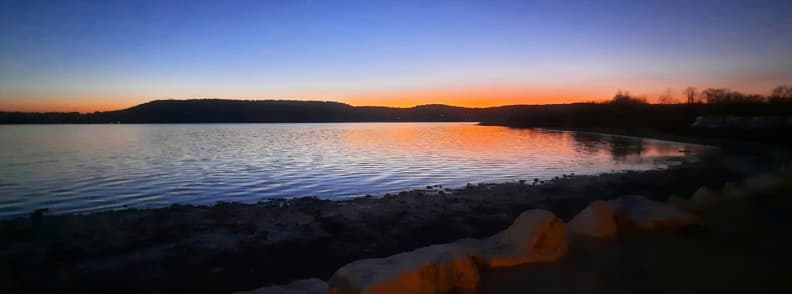
Outdoor & Nature. GR2013, Parc de la Poudrerie, Birding & Views
The first sound we heard at dawn near Saint-Chamas was the beating of wings. A pair of storks crossed the still water, heading to their nest near our parking spot. That morning was proof that wildlife in Étang de Berre doesn’t wait for summer. Even in winter, the lagoon is alive.
Étang de Berre offers easy access to open landscapes where trails, birds, and light shape the day. Calm, spacious, and full of surprises, it’s an underrated area for walking, cycling, and photography.
For hikers, the GR2013 trail passes near the northern shore and loops through fields, villages, and wooded slopes. The trail is well-marked and manageable even for beginners. Some stretches follow the waterline; others climb slightly above it, giving panoramic Étang de Berre viewpoints where you can stop for photos. Spring is the best time for these trails if you want to enjoy dry paths, fresh wind, and flowers along the verges.
If you prefer gentle movement, try short nature walks around Étang de Berre near Miramas or Saint-Mitré-les-Remparts. The paths there stay close to the reed beds, and in early morning or late afternoon, you’ll see herons and egrets fishing in the shallows.
The Parc de la Poudrerie, between Saint-Chamas and Miramas, is the heart of local biodiversity. This old gunpowder factory site has turned into a patchwork of wetlands and pine forest, open for visitors year-round. It’s one of the best areas for Étang de Berre birdwatching: flamingos, herons, ospreys, and even pond turtles. Bring binoculars and stay quiet. The birds here are close enough to watch without leaving the main path.
Photographers will find endless photo spots around Étang de Berre. The light changes fast, especially near the water, and reflections double the effect. Cornillon-Confoux is a favorite high viewpoint. From up there, the lagoon stretches out like a mirror framed by low hills. The Chapelle de la Miséricorde above Saint-Chamas and the Aqueduct overlook nearby are also strong locations for late-day color.
For sunset, pick your angle carefully. The best answer to where to watch sunset Étang de Berre? depends on the wind. On still evenings, the west side near Saint-Chamas catches gold light over the water. When the mistral blows, go to the Martigues side instead. That’s where the air clears, and the horizon sharpens.
I spent that winter morning watching storks circle above the lake and knew I’d return in spring. These natural corners show a side of Provence that’s quieter than the lavender fields but just as rich. You don’t need to go far. The lagoon itself gives you a full day outdoors.
Visit Étang de Berre Advice: Check wind forecasts before hiking or photographing. A mistral day means strong light and sharp skies, but it can make the trails dusty and the water choppy.
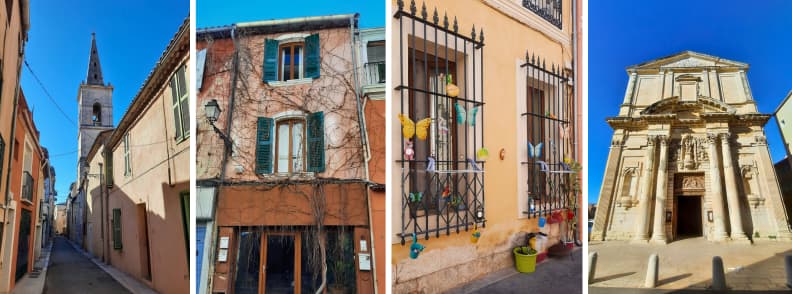
Local Culture & Étang De Berre Annual Events
Even though we came in February, when towns sleep early and squares stay quiet, we could still sense how much life fills the lagoon when the season turns. The small harbors and promenades are built for gatherings. Once spring arrives, the rhythm changes fast, and the Étang de Berre festivals begin.
The region’s culture runs on light, water, and community. Every town around the lagoon has its own celebrations, open-air concerts, and weekly markets where locals meet.
In summer, Martigues becomes the cultural center of the lagoon. The Fête de la Mer Martigues honors the town’s fishing roots with parades of boats, fireworks, and local seafood stalls along the canals. The Soirée Vénitienne Martigues, inspired by the city’s nickname Venice of Provence, fills the water with floating lanterns and music. Both are the kind of Étang de Berre events that bring locals and travelers together. They’re lively but still personal, not tourist shows.
Nearby, the Fête de l’Étang connects the surrounding communes through concerts, regattas, and exhibitions that celebrate the lagoon’s identity. It’s one of the biggest cultural festivals near Étang de Berre, often spread across several weekends. Add to that a program of summer concerts and open-air cinema screenings in Martigues and Saint-Mitre-les-Remparts, and you’ll find a warm, low-pressure version of Provençal nightlife.
For smaller traditions, the local markets Étang de Berre area are the real cultural constant. The Martigues market runs on Thursday and Sunday mornings, spreading along the quays with fruit, cheese, olives, and artisan stalls. In Saint-Chamas, market day is Wednesday, and it feels more local, more intimate. It’s a good place to buy olive oil, handmade soap, or a slice of poutargue to take home. Daytime also brings a handful of artisan shops Saint-Chamas tucked near the main square, where you can meet potters and small producers still working by hand.
I didn’t see any of the festivals myself (visiting in winter means quiet streets and closed stages), but that calm had its charm. Off-season, you can walk freely through empty alleys, talk with shop owners who have time to chat, and take photos without crowds. It’s a different kind of cultural experience, one that shows the everyday Provence behind the postcards.
If you return in summer, time your stay around cultural events Martigues to feel the town at its liveliest. And if you come in the off-season, enjoy the silence; it tells its own story of the lagoon.
Local Étang de Berre Tip: Book accommodation early in July and August. Festival nights fill Martigues quickly, and parking near the old port disappears hours before events start.
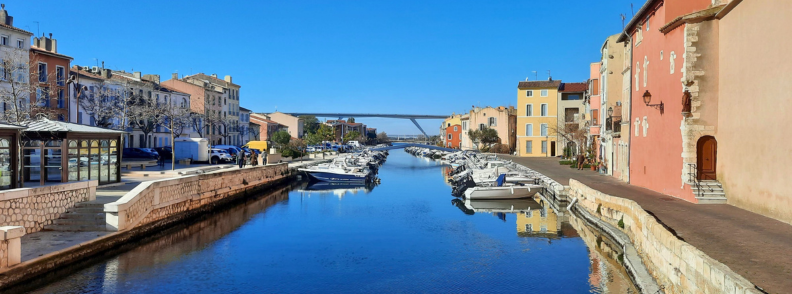
Étang de Berre Itineraries. Two Perfect Days Around the Lagoon
For travelers planning a self-guided tour Étang de Berre, the lagoon fits neatly into a weekend. The distances are short, the scenery changes fast, and every stop gives a new angle on the water. This area rewards slow exploration, not rushing. Whether you’re after a calm day trip Étang de Berre from Marseille or Aix, or a full two-day loop around the lake, the route below covers both the cultural and natural sides of the region.
The Travel Bunny Tip: Étang de Berre works best as a loop. You can hike, cycle, drive, or mix all three depending on the season and your energy.
Étang de Berre Weekend Itinerary
Start in Martigues, the liveliest town on the lagoon. Walk through the old quarter, photograph the Miroir aux Oiseaux, and grab coffee by the canals before heading to Ferrières Beach for a short swim or stroll. From there, drive north to the Cornillon-Confoux viewpoint, one of the best elevated spots for photography. The road winds through olive groves and small farms before dropping back toward Saint-Chamas.
Spend the evening in Saint-Chamas. Visit the Pont Flavien at golden hour, when the limestone glows as the sun sets, then have dinner early in town. In summer, the cafés stay open late; in winter, plan to eat before dark. If you travel by camper, the lakefront parking by the park makes a safe and scenic overnight stop.
On your second day, begin with the Parc de la Poudrerie, the green heart of the lagoon. You can do a gentle Étang de Berre hiking loop through pine forest and wetland trails before continuing to Miramas-le-Vieux, a stone hilltop village with views over the lagoon. From there, take the scenic road back to Martigues for sunset. The reflections from Quai Brescon end the trip perfectly, especially if you’re into photo spots around Étang de Berre or light-and-water compositions.
If you prefer cycling, you can combine parts of this loop. Try cycling from Saint-Chamas to Martigues, a route that stays close to the water and passes small fishing coves and salt meadows. Quiet roads, minimal traffic, and plenty of stops for photos make it one of the most relaxed rides in Provence.
Alternative: Our Provence Weekend Itinerary
Our own route was a little different. We came from Les Baux-de-Provence on a cold February weekend, driving west with the camper. By sunset, we reached Saint-Chamas, parked by the lake, and watched the sky fade into the water. The town looked peaceful at first, but later, after dark, it felt empty. It’s one of those places that changes mood completely when the lights come on.
The next morning, we drove on to Martigues. The town was brighter, with cafés open and the canals shining under soft light. Even off-season, it felt alive, with boats on the water and children cycling on the promenade. That contrast between the two towns said a lot about life around the lagoon.
On our way home, we wanted to stop for lunch in Carry-le-Rouet, the start of the Côte Bleue, but arrived on the weekend of Les Oursinades de Carry-le-Rouet, the local sea urchin festival. The town was jammed and there was no parking anywhere, even less for a 7 meter camper. We gave up and drove on, ending up eating sandwiches at a service station along the highway. It was the least glamorous end to a Provençal weekend, but part of the story.
Carry-le-Rouet itself deserves a visit another time. The peace of the Étang ends there, replaced by a modest seaside bustle. It’s a small resort popular with divers and families, with a marina, a casino, and an offshore marine reserve. It was also home to Nina Simone, who lived her final years here. West of Carry, the Côte Bleue flattens toward Martigues, passing Sausset-les-Pins and the quieter beaches of Carro and La Couronne. These sandy family resorts feel relaxed, though their backdrop of industrial chimneys reminds you how closely nature and work coexist in this part of Provence.
This winter itinerary connecting Les Baux to Saint-Chamas, Martigues, and the coast, shows both sides of the region: calm inland light and raw, living seafront. In summer, the same route feels completely different, filled with swimmers, boats, and open terraces. In winter, it’s yours alone.
The Travel Bunny’s Advice: The best top day trips from Étang de Berre include short drives to the Côte Bleue beaches or inland to the Alpilles. Distances are short; every hour brings a new face of Provence.
Visit Étang De Berre With Kids. Family-Friendly Tips & Safety
Planning an Étang de Berre family trip is easier than most travelers expect. The lagoon’s still water, easy roads, and short distances make it ideal for families with kids, whether you travel by car, bike, or camper. Most beaches are shallow, playgrounds sit near the shore, and there’s always a café or picnic bench within reach.
This region works best for slow, simple family travel. Choose safe spots, avoid industrial corners, and plan around the sun and wind.
The best kid-friendly beaches Martigues are Ferrières Beach in the center and Romaniquette Beach in Istres. Both have lifeguards in summer, showers, and nearby cafés. The sand is soft, and the water stays shallow for meters out, perfect for small children. These beaches also have good access for strollers and shaded benches where parents can rest.
Families who prefer nature over crowds will love the picnic areas Étang de Berre. Two stand out: the lakefront park at Saint-Chamas, where I parked the camper, and the Parc de la Poudrerie near Miramas. Both have wide lawns, trees for shade, and tables for a proper picnic. At Saint-Chamas, the playground and outdoor fitness area sit right by the water, so you can relax while kids play.
If your children like dinosaurs, stop at Dinosaur’Istres, a free outdoor park built along the lakeside gardens of Entressen. Life-sized models of T-rex, Triceratops, and other prehistoric creatures hide among the pines. It’s simple, outdoors, and perfect for a short break between drives.
For older kids and active families, there are safe cycling paths around the lagoon. Friends who live nearby recommended them for being flat and quiet, away from main traffic. Many routes run close to the water, linking Martigues, Istres, and Saint-Mitré-les-Remparts. They’re ideal for short family rides or sunset views.
From a safety perspective, the lagoon feels peaceful, but some caution helps. Avoid the industrial zones around Fos-sur-Mer, where access roads can be busy and views uninviting. Keep water handy in summer; the sun hits hard, and shade isn’t always nearby. When the mistral wind blows, the air turns sharp and dry. It’s good for photos but can make picnics difficult. Secure towels and light gear before it scatters everything.
At night, things go quiet fast. When we camped by the lake in winter, it was silent, safe, but completely dark. No streetlights, not a lot of people, just the sound of leaping water. For families, this solitude can feel peaceful or unsettling depending on your mood, so bring good lighting if you’re sleeping in a van or walking after sunset.
For casual afternoons, stick to nature walks around Étang de Berre. Paths near the Parc de la Poudrerie or Saint-Chamas park are flat and easy for all ages. Combine them with a picnic, short swim, or sunset break.
Étang de Berre Family Travel Tip: Carry snacks and water year-round, especially in low season. Many kiosks and cafés close early, and shade is limited. With that in mind, the lagoon stays one of Provence’s best calm spots for family travel. It’s safe, simple, and quietly beautiful.
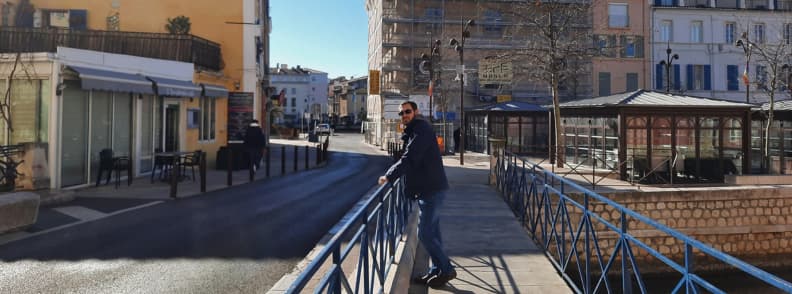
Étang De Berre Practical Tips. Weather, Seasonality & Costs
Knowing when to go can make or break your trip. The Étang de Berre weather follows a true Mediterranean rhythm with long, hot summers and short, mild winters. Days are bright, skies are clear, and the mistral wind keeps the air dry and sharp. But not every month feels the same, and timing changes what you’ll find open.
The best time to visit Étang de Berre is between April and June, or again in September and October. The heat softens, the water stays pleasant, and restaurants run normal hours. July and August bring higher prices and busier beaches, though the lagoon never reaches Riviera crowds. If you travel in high summer, go early in the day for calm and cooler light.
When To Visit Étang De Berre: Spring and early autumn give you the best balance. It’s quiet enough to enjoy, warm enough to swim.
Winter transforms the area completely. When we came in February, most towns were silent. Restaurants closed early, and the streets emptied after sunset. Yet that same stillness gave us clear views, easy parking, and soft light for photography. For travelers who prefer peace over comfort, the off-season is a quiet gift.
For budget travel Étang de Berre, the low season always wins. Hotels drop rates by a third, and even midrange stays in Martigues cost less than city rooms in Marseille or Aix. Campsites close in winter but reopen with good deals in spring. Eating out remains affordable, and you’ll find simple local menus under €25 and pizzas under €15.
As for Étang de Berre travel restrictions, there are no special rules beyond normal French regulations. Public transport runs year-round, but schedules shrink outside summer. Many beaches only open for swimming between June and September, when water testing resumes and lifeguards return. Always check the official site baignades.sante.gouv.fr for updates on bathing zones or safety notices.
The climate rewards flexibility. In summer, bring sun protection and a refillable bottle. In winter, pack layers because the mistral makes evenings colder than the thermometer suggests. Whatever the month, plan your days around light. Sunrise and sunset turn the lagoon into a mirror, and both last long enough to slow you down.
Etang de Berre Travel Tip: Avoid planning long outdoor meals at noon in July or August. The sun is too strong, and shade is scarce. Eat early or late, move often, and save the golden hours for exploring or photos.
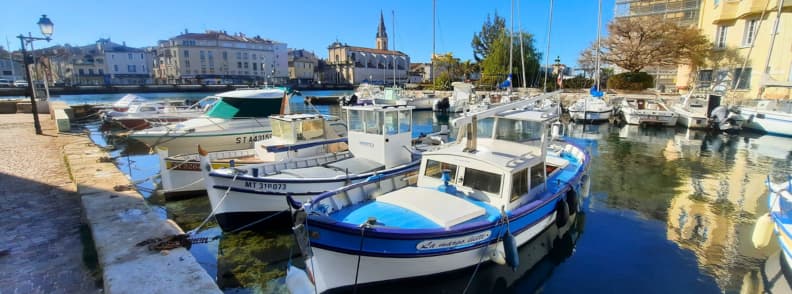
Visit Étang de Berre FAQs
If you’re planning a trip and want fast, reliable answers before you go, this section covers the most common questions about visiting Étang de Berre. Each answer comes from firsthand experience, verified local sources, and current regional data, so you can plan your trip with confidence.
What is Étang de Berre?
Étang de Berre is a vast brackish lagoon located about 25 km west of Marseille, in the Provence-Alpes-Côte d’Azur region of southern France. It stretches roughly 20 km east to west, making it the second-largest saltwater lagoon in Europe. Surrounded by towns like Martigues, Saint-Chamas, Istres, and Berre-l’Étang, it connects to the Mediterranean Sea through a narrow channel at Port-de-Bouc. The lagoon combines natural beauty, small working ports, and easy access from major cities. It’s ideal for a weekend escape from Marseille or Aix-en-Provence.
Is Étang de Berre polluted?
Not anymore. The lagoon suffered from industrial pollution during the twentieth century, but cleanup efforts since the 2000s have improved conditions dramatically. Today, official monitoring by baignades.sante.gouv.fr shows several beaches with Excellent or Good water quality ratings. Continuous treatment of wastewater and strict industrial controls have restored much of the ecosystem. You can safely swim in marked areas, and fish have returned to the water.
Where can you swim?
The best swimming spots include Ferrières Beach in Martigues, Les Cabassons nearby, and Romaniquette Beach in Istres. These areas are monitored during the summer season and have posted quality reports. Ferrières and Les Cabassons usually receive Excellent ratings; Romaniquette is more variable but still popular for families. Before swimming, always check live data on baignades.sante.gouv.fr for up-to-date results on water quality and safety.
Why is Martigues called the Venice of Provence?
Martigues earned the nickname Venice of Provence because the town sits on three small islands linked by bridges and canals connecting the Étang de Berre to the Mediterranean. Boats moor beside pastel houses, and the canals mirror the colors of the façades at dawn and dusk. The compact size and open water views give Martigues the intimacy of a small Venetian quarter, with Provençal character instead of marble palaces.
Is Martigues worth visiting?
Absolutely. Martigues is authentic, photogenic, and easy to reach. You can walk everywhere without using a car, from canal cafés to the Miroir aux Oiseaux harbor, the Ziem Museum, and Ferrières Beach. It’s an excellent base for exploring the lagoon, taking short boat tours, or connecting to the Côte Bleue beaches. Even off-season, Martigues keeps a relaxed rhythm and open cafés, unlike many coastal towns that close completely in winter.
How far is Saint-Chamas from Marseille?
Saint-Chamas lies about 45 minutes from Marseille by car, following the A7 or A55 motorways. It’s also accessible by TER regional train (Marseille → Miramas → Saint-Chamas), though driving remains faster and offers better views.
What are the troglodyte houses in Saint-Chamas?
The troglodyte houses are old cliff-cut dwellings carved directly into limestone above the town. Built centuries ago, they sheltered local families and artisans who worked near the aqueduct and harbor. Today, you can see the façades and openings along the cliff path above the old center, a fascinating glimpse into how people once adapted to the rock landscape. Combine this stop with the nearby Pont Flavien, a well-preserved Roman bridge from the first century BC.
When is the best time to visit?
The best time to visit Étang de Berre is in spring (April-June) or autumn (September-October), when temperatures stay mild, restaurants are open, and hiking and cycling are comfortable. Summer brings more heat and local crowds, while winter offers solitude, lower prices, and soft light for photography. I visited in February and most cafés were closed, but the peace and colors made up for it.
Are there festivals?
Yes. Major Étang de Berre festivals include the Fête de la Mer in Martigues (a maritime celebration with parades and fireworks), the Soirée Vénitienne (lantern-lit boat processions on the canals), and the Fête de l’Étang, which unites towns around the lagoon with concerts, markets, and regattas. Smaller summer events feature open-air cinema and live music. Check local tourism sites in June for exact dates.
Can you camp near the Étang de Berre?
Yes. Several lakeside Aires and campsites sit directly on the lagoon. The best-rated is Camping Félix de la Bastide in Saint-Mitré-les-Remparts, offering pitches and mobile homes beside the water. Camping Marina Plage, near Marignane, caters to kitesurfers and windsurfers. Camper vans can park for free by the Saint-Chamas lakeshore next to the public park: flat, safe, and quiet. Always check seasonal opening dates; many sites close from November to March.
Étang de Berre is safe, close, and full of small surprises. Whether you come for the beaches, walks, or culture, the lagoon offers the kind of quiet, local experience that Provence often hides behind its more famous coast.
A Quiet Lagoon Worth Rediscovering
The Étang de Berre is one of Provence’s most overlooked landscapes, a place that feels close yet far, quiet yet full of life. Travelers often drive past it on their way to the Camargue or the French Riviera, never realizing how much this lagoon in southern France offers. Between the canals of Martigues, the Roman bridge of Saint-Chamas, and the open trails around Miramas, the area holds a mix of water, history, and stillness that’s hard to find anywhere else.
This lagoon is not a detour; it’s a destination. Visiting the Étang de Berre gives you the calm of the countryside with the access to the coast. You can swim safely, hike gently, and watch flamingos take flight without fighting crowds.
For expats living in France or slow travelers passing through, it’s a place that grows on you, where you can spend a weekend doing almost nothing yet feel you’ve seen something real. Whether you come for the photography, the peace, or the seafood, the lagoon rewards patience and curiosity.
About the Author

I’m Mirela Letailleur, a Romanian travel writer based in the South of France and the voice behind The Travel Bunny. I specialize in slow, local travel across Provence, exploring places most tourists skip. I’ve visited the Étang de Berre, Martigues, and Saint-Chamas by camper, documenting quiet winter landscapes, local food, and practical travel routes from Marseille and Aix. My guides combine first-hand experience, verified facts, and clear travel logistics to help readers see authentic Provence.
As an expat living near the coast, I focus on budget-friendly travel, eco-conscious itineraries, and hidden gems in southern France. My work bridges storytelling with accurate information, from Étang de Berre beaches and birdwatching trails to authentic Provençal food like poutargue. I write for travelers and expats who want trusted advice from someone who’s been there, seen it in every season, and values the beauty of simple, local discovery.
After planning your visit to Etang de Berre, check out these PACA travel guides
Visit Saint-Cézaire Cave / Grotte de Saint-Cézaire. Your Full-Day Guide to the Domain
Guide to Visit Abbaye du Thoronet, a Cistercian Abbey in Provence
Provence Weekend in Carcès: Village, Caramy Falls & Thoronet Abbey

